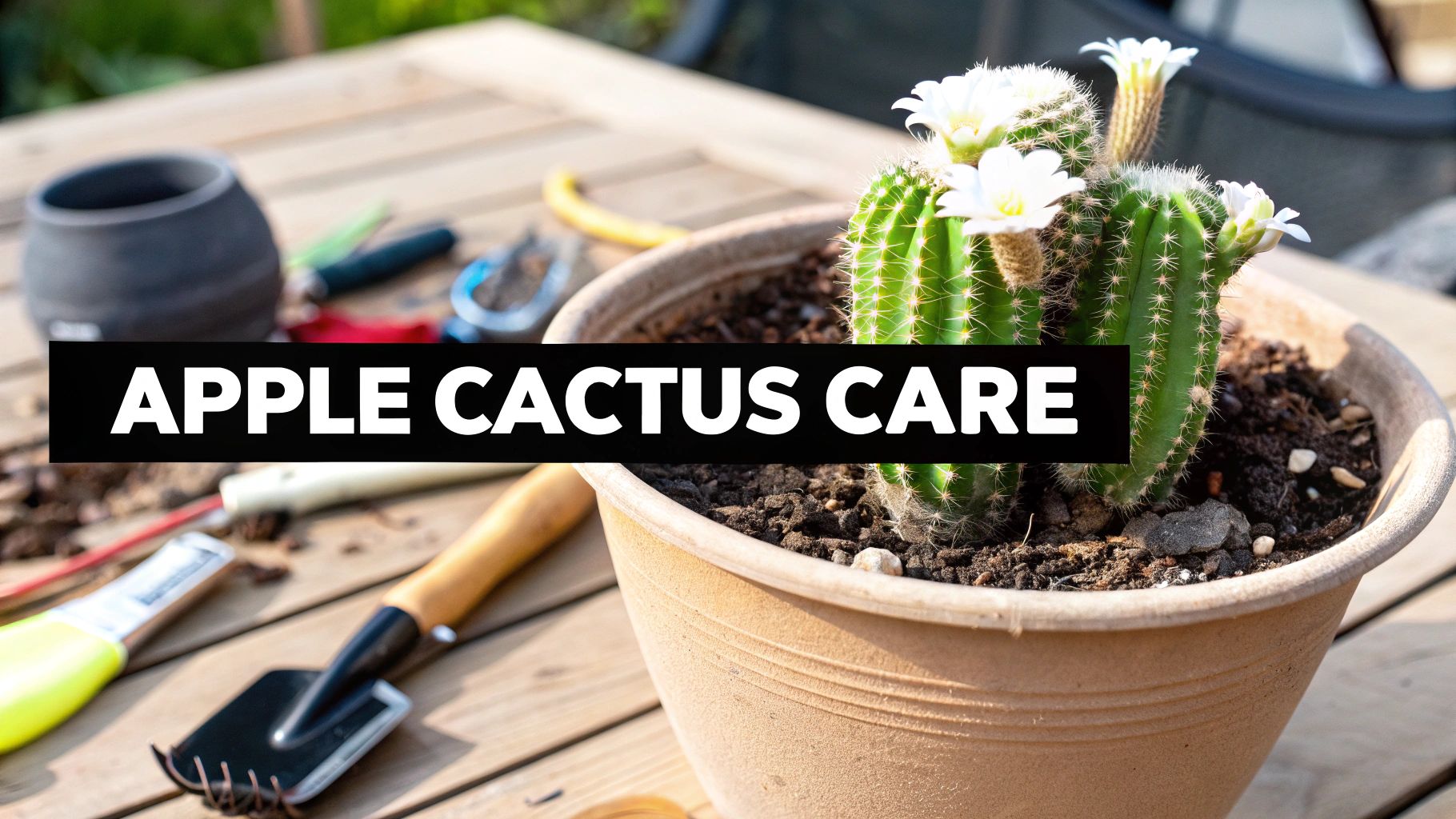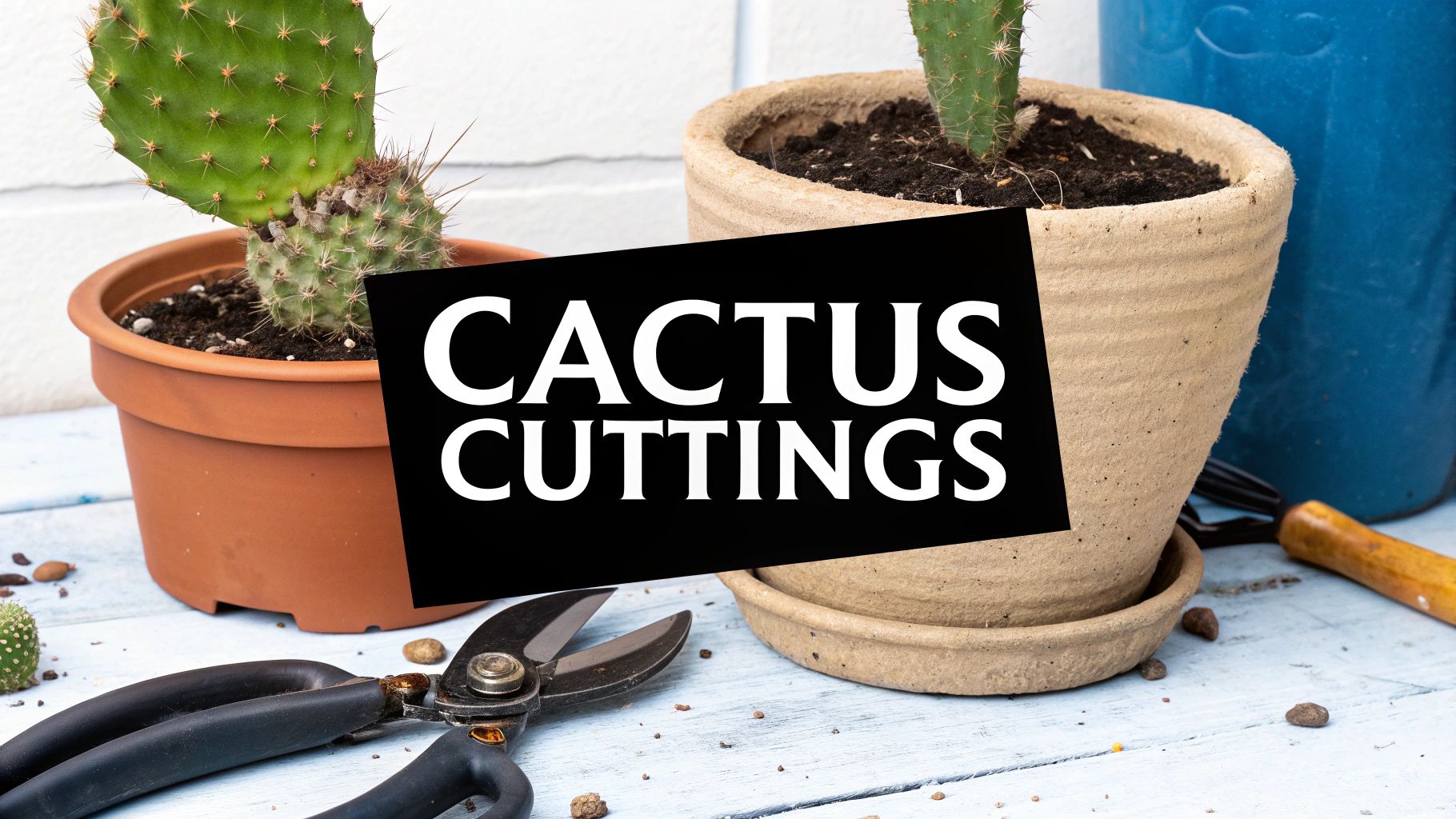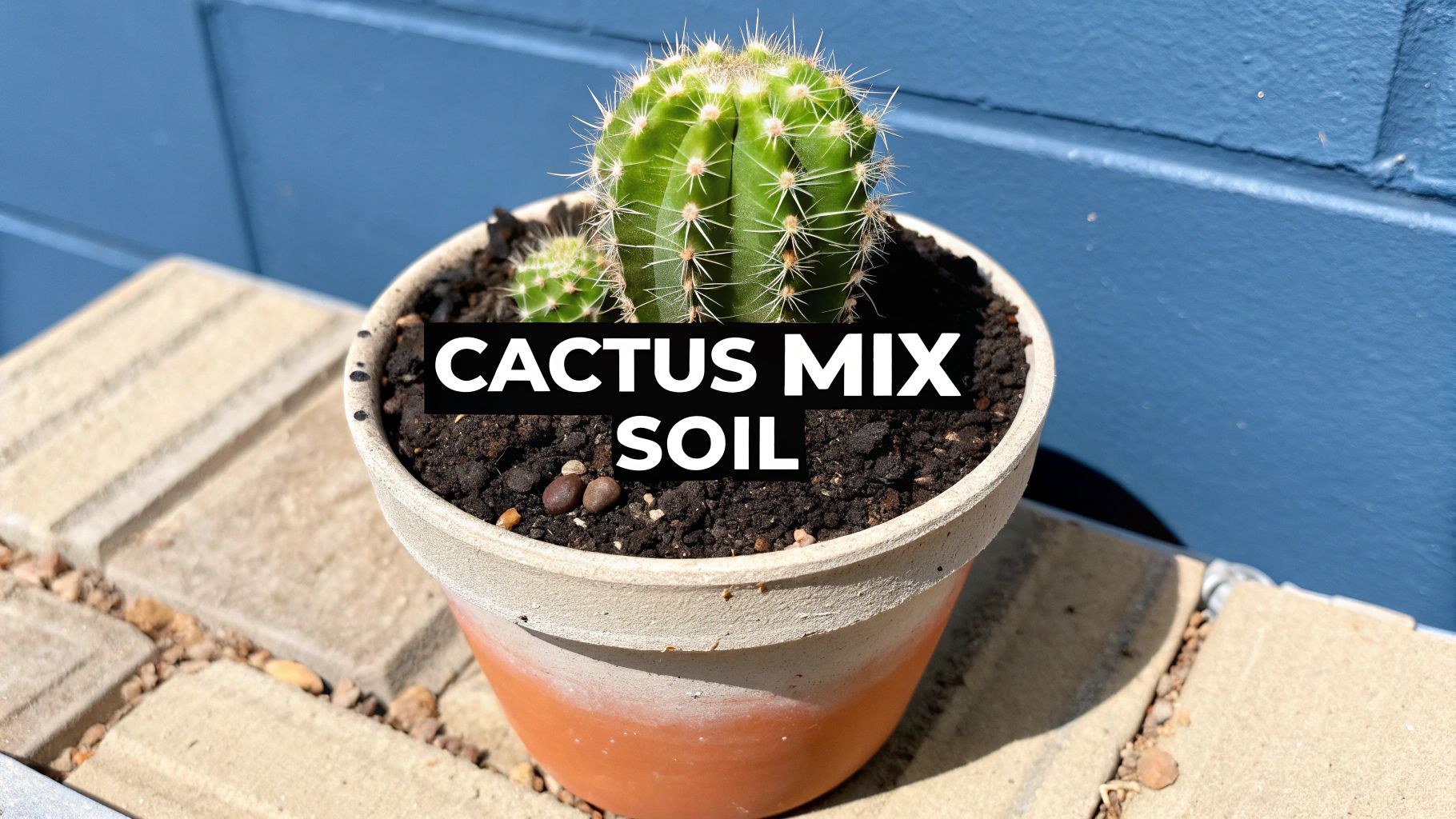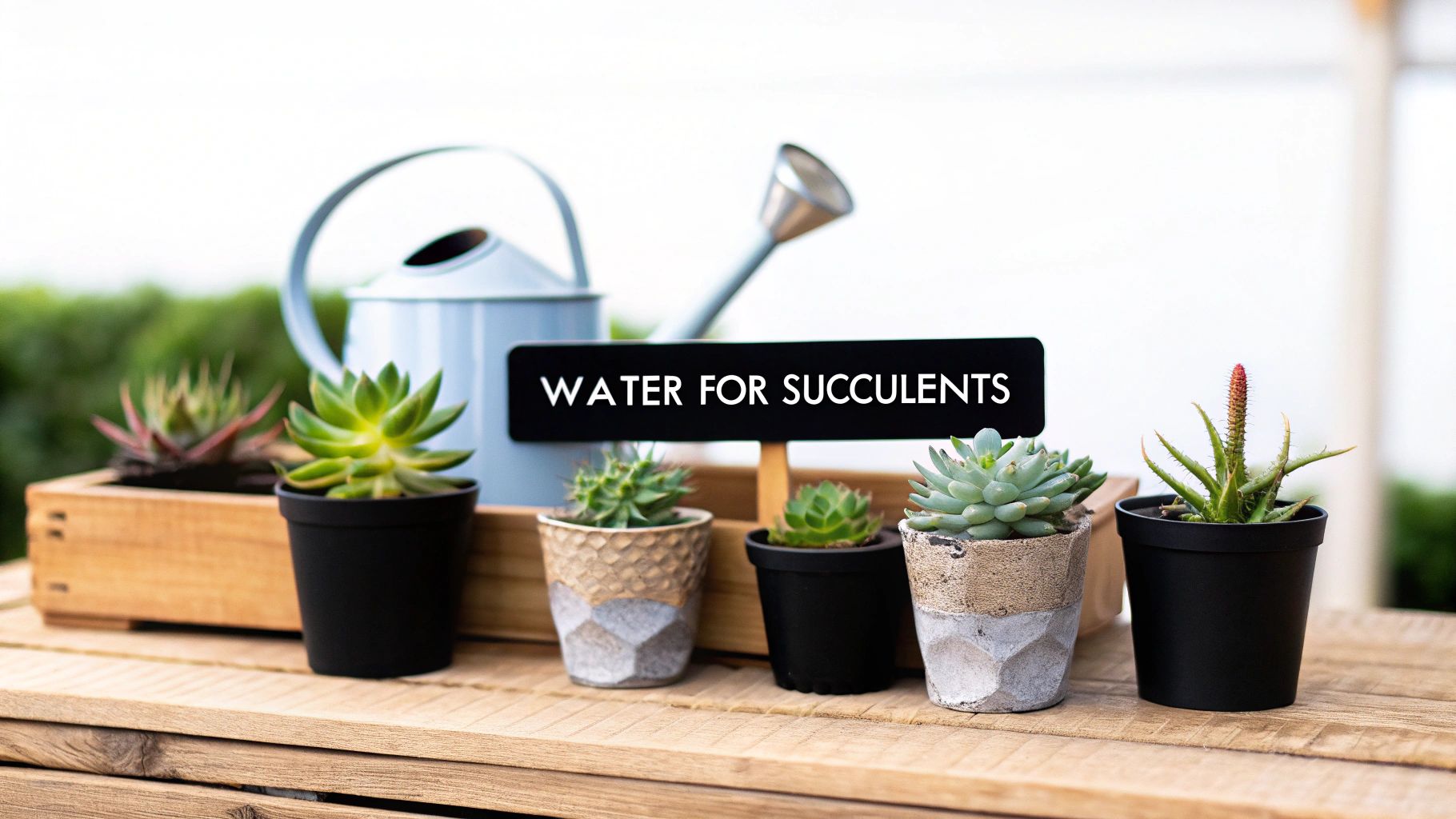Properly caring for a Peruvian Apple Cactus is all about mimicking its natural, arid environment. Think bright, direct sunlight, a gritty soil mix that drains in a flash, and deep but infrequent waterings. This tough plant thrives on a "soak and dry" cycle. Just let the soil dry out completely between waterings, and you'll sidestep the biggest cactus killer: root rot. Get these fundamentals right, and this stunning cactus will become a low-maintenance showstopper in your home or garden.
Discover the Majestic Peruvian Apple Cactus
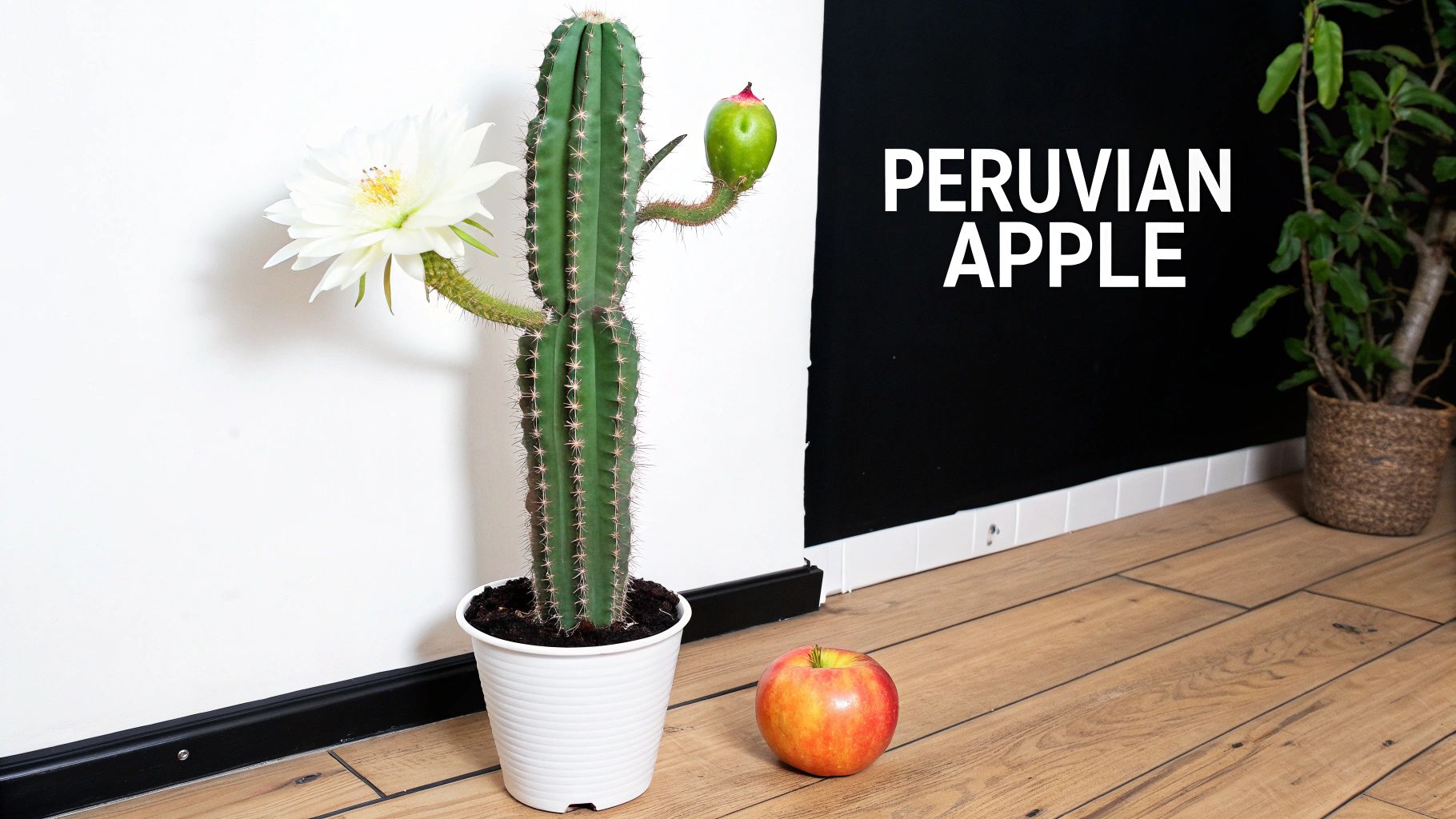
People often lump the Peruvian Apple Cactus (Cereus repandus) in with other desert plants, but it’s in a class of its own. This isn’t your average succulent; it’s a magnificent, tree-like cactus that brings serious architectural drama with its tall, columnar, blue-green stems.
It's a huge favorite for both beginners and experienced gardeners, and for good reason. The care is surprisingly simple, and watching it grow is incredibly rewarding. Unlike more demanding houseplants, the Peruvian Apple Cactus is quite forgiving, making it a perfect first step for anyone wanting to get into cacti.
Origins and Unique Characteristics
Hailing from the dry landscapes of South America, this plant is engineered for survival. Knowing where it comes from is the key to understanding its needs—it craves sunshine and absolutely hates having soggy roots. You can dive deeper into the incredible variety of plants from this region in our article on the https://www.cactusoutlet.com/blogs/blog/cacti-of-south-america.
One of its most spectacular traits is its habit of blooming at night. The Peruvian Apple Cactus produces huge, fragrant white flowers that are an absolute spectacle.
These incredible blooms, measuring about 6 inches (15 cm) across, open only after dusk and are gone by morning. This fleeting, beautiful display is a clever strategy to attract nocturnal pollinators like moths and bats.
More Than Just a Pretty Face
The "apple" in its name isn't just for show. After flowering, the cactus produces a delicious, apple-like fruit, often called pitaya or cactus apple. It's completely edible and has a unique flavor that many people say is a cross between a kiwi and a dragon fruit.
In the wild, this plant is a true giant, capable of reaching a staggering 33 feet (10 meters) tall. While the ones we grow at home or in gardens are usually a more manageable 10 to 15 feet, they still make a powerful statement. This combination of striking beauty, easy care, and edible fruit makes it a truly special addition to any plant collection.
Creating the Ideal Environment for Your Cactus
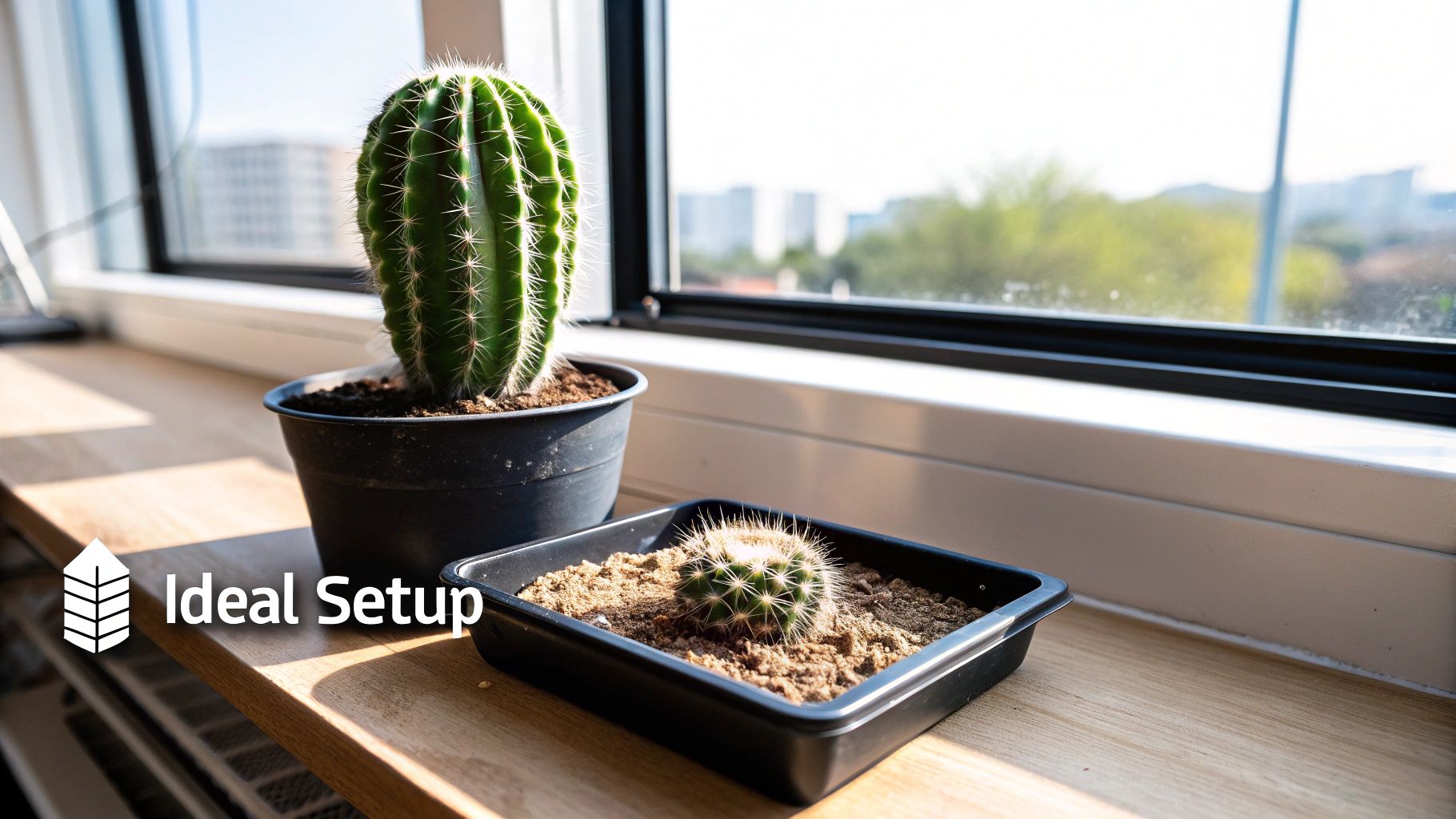
If you get one thing right with your Peruvian Apple Cactus, let it be the environment. These plants are tough, but they have a few non-negotiable needs that trace back to their native South American habitat. Nailing the light, soil, and temperature from day one is the secret to avoiding almost every common problem down the road.
Think of it as setting the stage for a great performance. Without the right conditions, all the fancy fertilizers and perfect watering schedules in the world won't make a difference. Let's dig into the three pillars of a happy cactus home.
Mastering the Light Requirements
Sunlight is the lifeblood of this cactus, but more isn't always better. While they are "full sun" plants, that term can be a bit misleading. Blasting, direct afternoon sun, especially in scorching climates, can actually burn the cactus, leaving ugly bleached or yellow spots on its beautiful blue-green skin.
Your goal is simple: provide at least six hours of bright, direct sunlight every day. The quality of that sunlight is what really counts.
- Morning Sun Is King: An east-facing spot that catches the sun from morning until early afternoon is the absolute sweet spot. This light is bright and energizing without being harsh.
- Indoors? Go South: If your cactus lives inside, an unobstructed south-facing window is your best friend. It offers the most consistent and powerful light throughout the day.
- West-Facing Works, With a Catch: A west-facing window is a solid second choice, but keep an eye on it during summer heatwaves. The afternoon sun can be incredibly intense, so you might need to pull the pot back a foot or two from the glass to prevent scorching.
If you're still scratching your head about the best placement inside, our guide on https://www.cactusoutlet.com/blogs/blog/where-is-the-best-place-to-put-a-cactus-in-the-house breaks it down room by room. A cactus that's starved for light will start to stretch and lean towards the window, a tell-tale sign called etiolation.
Building the Perfect Soil Mix
If overwatering is the #1 killer of cacti, then heavy, dense soil is its accomplice. The Peruvian Apple Cactus has roots that are extremely prone to rot, so a gritty, fast-draining soil mix is non-negotiable. Your average bag of all-purpose potting soil is a death sentence; it holds onto way too much water for far too long.
You can either buy a pre-made cactus mix or, better yet, create your own custom blend. Commercial succulent soils are a decent starting point, but I almost always amend them with extra grit for better performance.
For a foolproof DIY recipe your cactus will thrive in, just combine these three ingredients in equal parts:
- One part potting soil (for nutrients)
- One part coarse sand (for drainage)
- One part perlite or pumice (for aeration)
When you're sourcing your materials, remember the importance of suitable aggregates for potting mixes. You're aiming for a final product that water rushes through, giving the roots a quick drink without ever letting them sit in a soggy mess.
Pro Tip: The perfect cactus soil should feel gritty and fall apart easily in your hand. If you can squeeze it into a clump that holds its shape, it's too dense and needs more grit.
Understanding Temperature and Hardiness
This cactus is a true sun-worshipper, thriving in the kind of heat that makes us run for the air conditioning. It's most comfortable in temperatures between 65–85°F (18–29°C), but it has no problem handling summer days that soar well above that.
The real danger is the cold. While it’s surprisingly tough for a cactus, it is not frost-proof. It can handle a brief, fleeting dip down to about 21°F (-6°C), but any prolonged exposure to freezing temperatures will cause permanent, mushy damage to its cells.
If you live in a cooler region (USDA Zone 8 or below), you'll need a winter game plan.
- For Potted Cacti: The simplest method is to plant it in a container you can move. When the first frost threatens, just wheel it into a protected spot like a garage or shed until spring.
- For In-Ground Cacti: If your cactus is a permanent fixture in your landscape, you’ll need to play defense on cold nights. Before sunset, cover the plant with a frost cloth or an old blanket to trap the ground's warmth. Just be sure to never use plastic—it traps moisture against the plant, which can make frost damage even worse.
How to Water and Feed Your Peruvian Apple Cactus
When it comes to keeping a Peruvian Apple Cactus happy, watering and feeding are a delicate dance. It’s far more about restraint and observation than anything else. Honestly, I've seen more of these incredible plants die from too much love (and water) than from a little neglect. The secret is to mimic the "feast and famine" cycles of their native desert home.
This means you need to ditch any rigid watering schedule, like "once a week on Sunday." Instead, embrace the "soak and dry" method. It's the gold standard for a reason—it’s simple, effective, and pretty much eliminates the risk of dreaded root rot.
Mastering the Soak and Dry Method
The name gives it away: you drench the soil completely, then let it dry out entirely before even thinking about watering again. It sounds easy, but the real skill is knowing for sure when the soil is properly dry. Guessing is a one-way ticket to a mushy, unhappy cactus.
The best tool for the job? Your own finger. Seriously. Just stick your index finger 2-3 inches down into the soil. If you feel even the slightest hint of dampness, walk away. Wait another few days. If it’s bone-dry and dusty, it’s go-time.
When you do water, don't be shy.
- Slowly pour water over the entire soil surface.
- Keep going until you see it running freely from the pot's drainage holes.
- Let it drain for a good 5-10 minutes to make sure it's not sitting in a puddle.
This deep-drench approach encourages the roots to grow strong and deep as they search for moisture throughout the pot. For a much deeper dive into this, our guide on watering cactus plants has even more pro tips.
Crucial Tip: A pot without drainage holes is a death sentence for a Peruvian Apple Cactus. It’s just not negotiable. Without drainage, water pools at the bottom, creating a swampy mess that will rot the roots, no matter how carefully you water.
Your Environment is the Boss
How often you water isn't a fixed number; it's a moving target based on your specific conditions. You have to be an observer and adapt.
- Sun & Heat: A cactus soaking up the sun in a south-facing window will get thirsty much faster than one in a lower-light spot. During a summer heatwave, you might be watering every 10 days, while in the cooler spring, it could be every 3-4 weeks.
- Pot Type: The pot itself makes a huge difference. Small pots dry out way faster than big ones. And porous terracotta pots? They "breathe," wicking moisture out through their walls, meaning they'll dry out significantly quicker than a non-porous plastic or glazed ceramic pot.
- Humidity: Where you live matters. In a dry, arid climate, the soil dries out in a flash. But if you're in a humid, coastal area, that soil will hold onto moisture for much longer, so you’ll need to stretch the time between waterings.
Giving Your Cactus a Nutritional Boost
These guys aren’t heavy feeders, but a little bit of the right food during their growing season can really kick things into high gear. Think of fertilizer as a gentle supplement, not a five-course meal. The right approach will support strong, healthy growth and encourage those amazing nocturnal flowers to show up.
The prime time for growth is spring and summer. This is the only window you should be fertilizing. Come fall and winter, the cactus hits the brakes and goes into a dormant phase. Feeding it during this rest period is a bad idea—the unused nutrients can build up in the soil and burn the roots.
Always grab a fertilizer specifically made for cacti and succulents. These are formulated with a low-nitrogen blend, which is vital. A standard, high-nitrogen houseplant food will just encourage weak, stretched-out growth that's a magnet for pests.
Here's a simple, effective feeding plan:
- When: Every 4-6 weeks during the spring and summer. Start when you see new growth, and stop at the end of summer.
- How: Always dilute a liquid cactus fertilizer to half the strength recommended on the bottle. It's always, always safer to under-feed than to over-feed.
- Pro Tip: Never apply fertilizer to bone-dry soil. Water the plant lightly the day before, then feed. This prevents the fertilizer from shocking and burning the sensitive roots.
Pruning, Repotting, and Propagation
While the Peruvian Apple Cactus is a champ at taking care of itself, a little hands-on attention every few years will keep it healthy and looking sharp. Things like pruning, repotting, and propagation might sound like a big deal, but they’re actually pretty simple.
Think of it less like a chore and more like a chance to connect with your plant and guide its growth. A little proactive care goes a long way, helping you spot potential issues before they start and cultivate a stunning cactus that can live for decades.
When and How to Prune Your Cactus
Pruning a Peruvian Apple Cactus isn't about constant shaping; it's about strategic maintenance. The main reasons you’ll want to grab the shears are to clean up any dead or damaged sections and, occasionally, to manage its size or encourage a more balanced shape. Any damaged arms can be an open invitation for rot and pests, so snipping them off is just good plant hygiene.
Your most important tool here is a sharp, clean knife or saw. Before you even think about making a cut, wipe the blade down with isopropyl alcohol. This simple step is non-negotiable—it prevents you from accidentally spreading diseases from one part of the plant to another.
If you’re curious about the bigger picture of shaping plants, it can be helpful to understand some general pruning principles. When you’re ready to cut, make a clean slice right at the joint where an arm meets the main stem. This helps the plant heal over quickly and cleanly.
A Guide to Successful Repotting
Sooner or later, your cactus is going to need a bigger place. You'll know it's time to repot when you see roots peeking out of the drainage holes or when the plant starts to look top-heavy and unstable. Generally, this happens every 2-3 years. A new pot gives it fresh soil packed with nutrients and more room for its roots to stretch out.
The biggest hurdle is, of course, handling a giant spiky plant. The key is to protect both yourself and the cactus.
My favorite trick is to use old, rolled-up towels or thick strips of cardboard. Wrap them around the cactus stems to create a padded, spine-free grip. This saves your hands and keeps you from damaging the delicate waxy coating on the plant's skin.
Once you have a good hold, gently work the cactus out of its pot. Pick a new container that's only about 1-2 inches wider in diameter. If you go too big, the excess soil will hold onto water for too long, putting you at risk for root rot.
Fill the new pot with a quality cactus mix, place your plant inside at the same depth it was before, and backfill. Hold off on watering for at least a week to give any roots that might have broken a chance to heal.
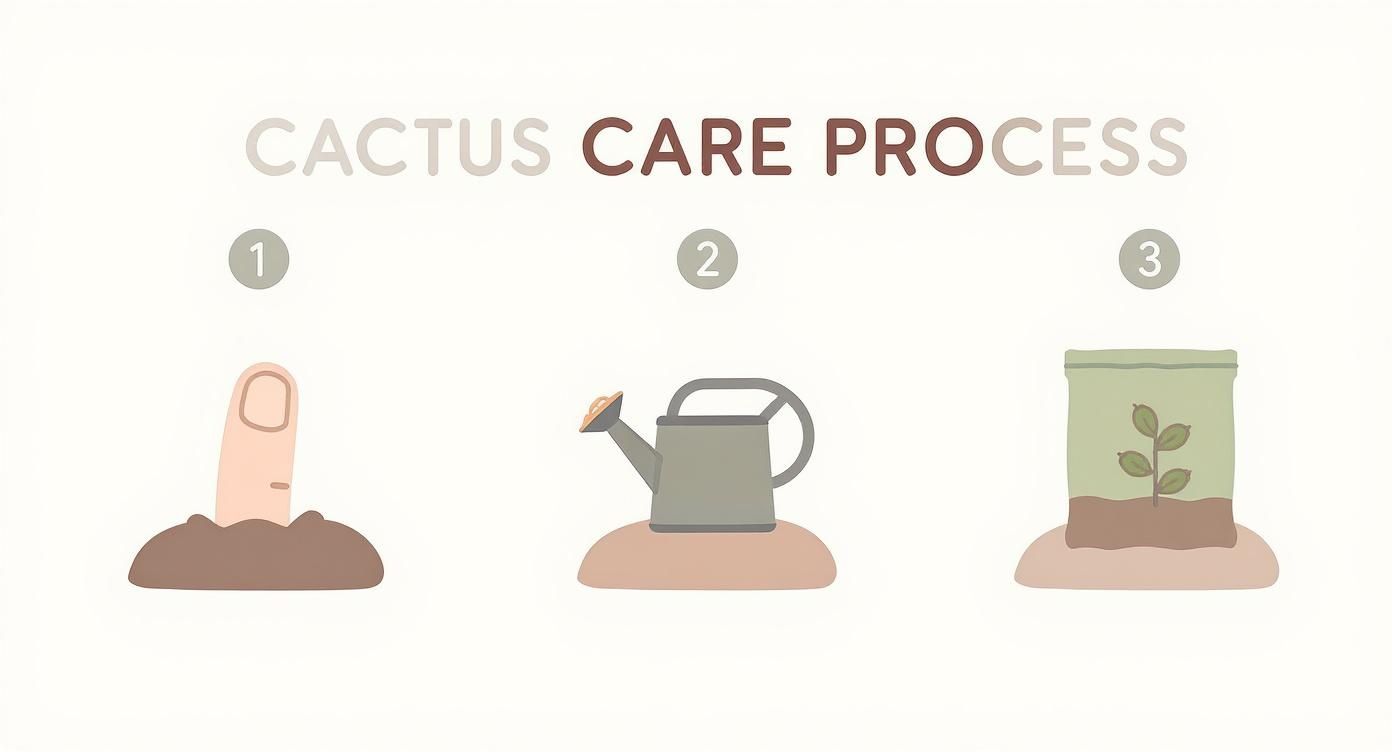
This visual is a great reminder that good care is a simple cycle: check on your plant first, then give it what it needs.
Propagating New Cactus Plants From Cuttings
One of the coolest things about owning a Peruvian Apple Cactus is how easy it is to make more of them. Propagation is a fantastic way to expand your collection or share plants with friends. All it takes is a few healthy cuttings from a mature plant.
Here’s how it’s done:
-
Take the Cutting: Using your sterilized knife, slice off a healthy arm. If you’ve just pruned your cactus, don’t toss those pieces! You can use them for propagation.
-
Let it Callus: This is the most important step, so don't rush it. Lay the cutting in a dry, shady spot for one to two weeks. The cut end needs to dry out and form a hard, protective scab called a callus. If you skip this, the cutting will almost certainly rot when you plant it.
-
Plant it: Once the end is dry and hard, gently push it an inch or two deep into a pot of dry cactus mix. You might need some small stakes or rocks to prop it up until it grows roots and can support itself.
-
Wait to Water: Resist the urge to water it right away. Give it a couple of weeks to start developing roots, then you can begin watering very sparingly, just like you do with the mother plant. It can take a few months for a cutting to establish a solid root system, so be patient
Troubleshooting Common Cactus Problems
Even a tough-as-nails plant like the Peruvian Apple Cactus can hit a snag now and then. But don't worry—spotting the signs early is your best defense, and most issues are just your cactus’s way of asking for a small tweak in its care routine.
Think of it this way: your cactus is always communicating. A weird color, a soft spot, or a lanky new arm is a clear signal. Once you learn to read these clues, you’ll be able to solve just about any problem that comes your way.
Pesky Pests and How to Evict Them
Your cactus is pretty self-sufficient, but if it gets stressed, it can become a target for a couple of common pests: mealybugs and scale. Both are sap-suckers that will weaken your plant over time if you let them set up shop.
Mealybugs are the easier ones to spot. They look like tiny bits of white cotton fluff, usually hiding in the nooks and crannies between the cactus ribs. Scale is a bit stealthier, appearing as small, hard, brown bumps latched onto the stems.
Getting rid of them is easier than you might think, and you won't need harsh pesticides.
- For a few freeloaders: Just dip a cotton swab in 70% isopropyl alcohol and touch it directly to each pest. The alcohol breaks down their waxy coating, and you can just wipe them off. Simple and effective.
- For a full-blown invasion: If you're dealing with a bigger colony, mix equal parts isopropyl alcohol and water in a spray bottle. Add a drop or two of mild dish soap to help it stick, give it a good shake, and thoroughly spray the affected areas. Just be sure to keep the plant out of direct sunlight until it's completely dry to avoid sunburn.
The Number One Enemy: Root Rot
If there’s one thing that can take down a Peruvian Apple Cactus, it’s root rot. This isn't just a disease; it's almost always a direct result of overwatering. When soil stays soggy, roots can't breathe. They start to decay, turning into a foul-smelling, mushy mess.
Above ground, the first signs can be subtle. You might see some yellowing near the base, or a stem that feels a little soft to the touch. If you suspect root rot, you have to move fast.
Emergency Surgery: The second you feel a mushy base or catch a whiff of rot, it’s time to intervene. Gently slide the cactus out of its pot and take a hard look at the roots. Healthy roots are firm and white or light tan. Rotted roots are brown or black, slimy, and fall apart easily.
To save your plant, grab a clean, sharp knife and start trimming. Cut away every single piece of rotted root and any mushy stem tissue. Keep cutting until you only see firm, healthy, green flesh. Let the cactus air-dry in a shady spot for several days until the cuts form a hard callus. Once it's callused over, you can repot it in fresh, completely dry cactus mix. Hold off on watering for at least a week to give it time to settle in.
Reading the Signs: What Your Cactus Is Telling You
Your cactus uses its physical appearance to tell you when something is off. Learning these visual cues lets you fix problems before they become serious.
Here’s a quick guide to help you translate what you're seeing.
Common Peruvian Apple Cactus Issues and Solutions
| Symptom | Potential Cause | Recommended Solution |
|---|---|---|
| Yellowing or Bleached Spots | Sunburn | Your cactus is getting scorched. Move it to a spot with bright morning sun but protection from intense afternoon rays. |
| Stretching or Leaning | Etiolation (Not enough light) | It's reaching for more light. Gradually introduce it to a brighter location with at least 6 hours of direct sun. |
| Mushy, Brown Base | Root Rot (Overwatering) | This is an emergency. Immediately unpot, trim all rot, let the cuts callus over, and repot in fresh, dry soil. |
| Wrinkled or Shriveling Stems | Underwatering | It's thirsty! The soil is likely bone-dry. Give it a deep, thorough watering until water runs out the bottom. |
Think of this table as your go-to diagnostic tool. By paying close attention, you can keep your Peruvian Apple Cactus looking its best for years to come.
Beyond a Houseplant: The Cactus Fruit
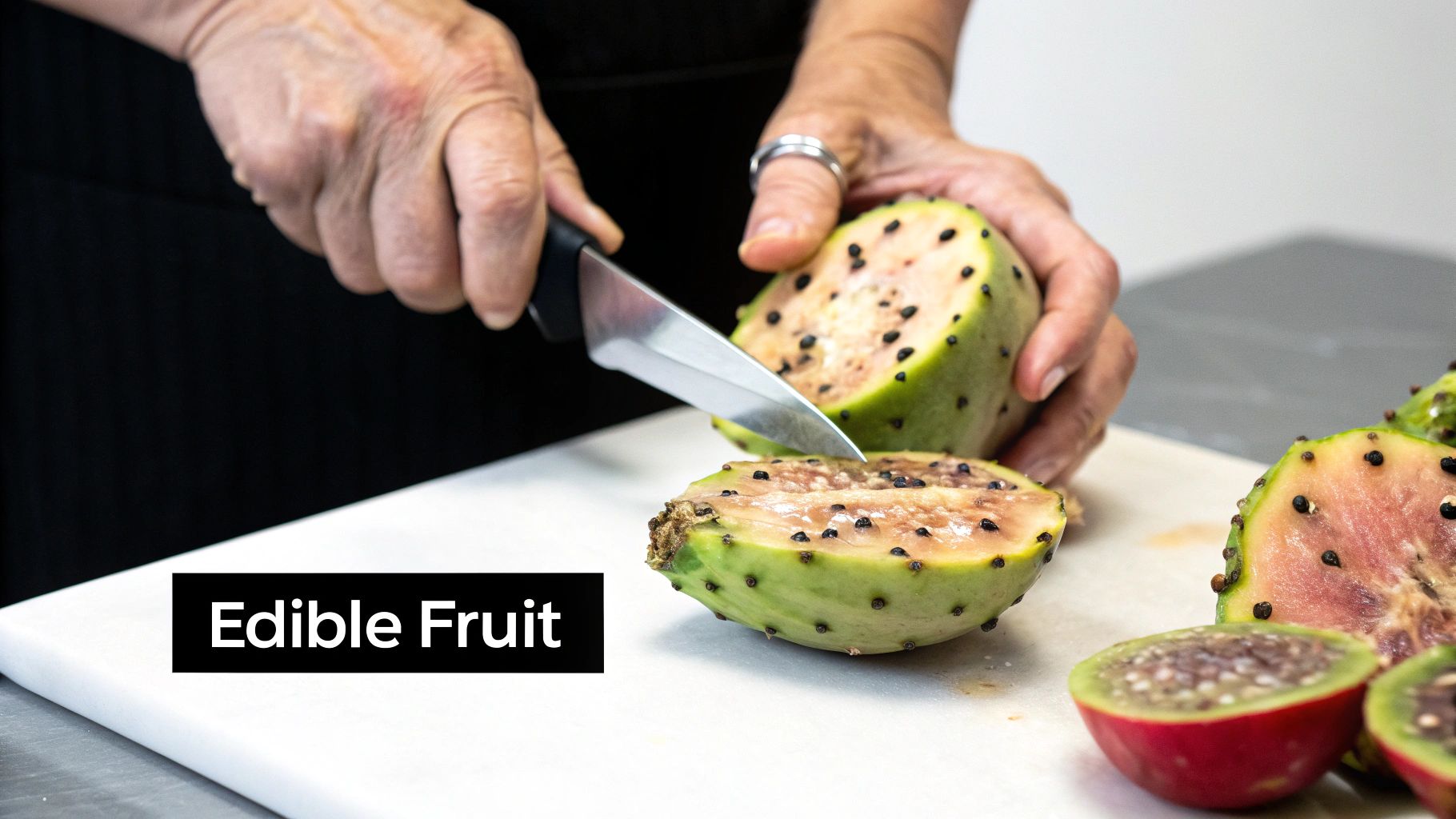
While its striking architectural form is what usually catches the eye, the Peruvian Apple Cactus holds a remarkable secret: it produces a delicious, edible fruit. This is where the "apple" in its name comes from, elevating it from a purely ornamental plant into something truly special.
For many of us who grow these giants, seeing our cactus flower and then bear fruit is the ultimate reward. It's a sign that we've really nailed its care. The fruit itself, often called a pitaya or cactus apple, is a smooth-skinned, thornless globe that ripens into a stunning reddish-pink or deep magenta.
What Does the Cactus Fruit Taste Like?
If you've never had one, you're in for a treat. The flavor is often described as a delicate mix of kiwi and dragon fruit—it's mildly sweet with a subtle tang that is incredibly refreshing. Inside, the texture is like a firm melon or a perfectly ripe pear, filled with tiny, crunchy black seeds, much like a kiwifruit.
The trick is knowing the perfect time to harvest. Pick it too early, and it'll be bland and hard. Wait too long, and it can get mushy.
Here’s what I look for to know when a cactus apple is perfectly ripe:
- Vibrant Color: The skin should have a deep, uniform red or pink hue. Any green patches are a dead giveaway that it needs more time on the stem.
- Gentle Give: When you gently squeeze it, the fruit should feel slightly soft, much like a ripe peach.
- Easy Detachment: A ready-to-eat fruit will twist off the cactus with very little effort. If you find yourself having to pull hard, just leave it be for a few more days.
For the best flavor, I always chill the fruit in the fridge for about an hour before cutting into it. The cool temperature really brings out its subtle sweetness and makes it an amazing treat on a warm day.
A Symbol of Sustainability
Beyond being a unique homegrown treat, the Peruvian Apple Cactus is gaining serious attention for a much bigger role: a sustainable and economically vital crop. Its incredible drought resistance and minimal water needs make it a game-changer in arid regions where traditional farming is a constant struggle.
In places facing severe water shortages, like parts of Israel, farmers are now turning to this resilient plant. It’s becoming an economically important crop, in some cases even replacing old, water-guzzling orchards. One of its biggest advantages is the ability to produce fruit year-round, unlike most fruit crops with very limited harvest seasons. This provides farmers with a steady, reliable income. You can learn more about its role in sustainable farming on Specialty Produce.
This dual identity is what makes the Peruvian Apple Cactus so fascinating. The plant in your living room isn't just a beautiful succulent; it's a symbol of adaptation and a potential food source for a drier future. It's a living example of nature's brilliant solutions, all wrapped up in a plant that produces a delicious, exotic fruit.
At The Cactus Outlet, we believe every plant tells a story of resilience and beauty. From towering statement pieces to unique fruiting varieties, find the perfect cactus to start your own story. Explore our collection today at https://www.cactusoutlet.com.

